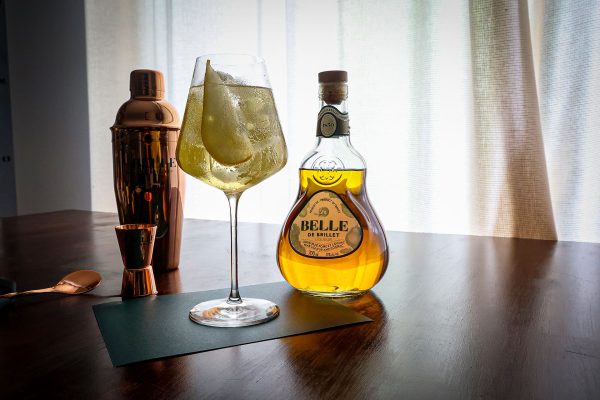Belle de Brillet Celebrates Its 40th Anniversary: Interview With Jean-Baptiste Sialelli
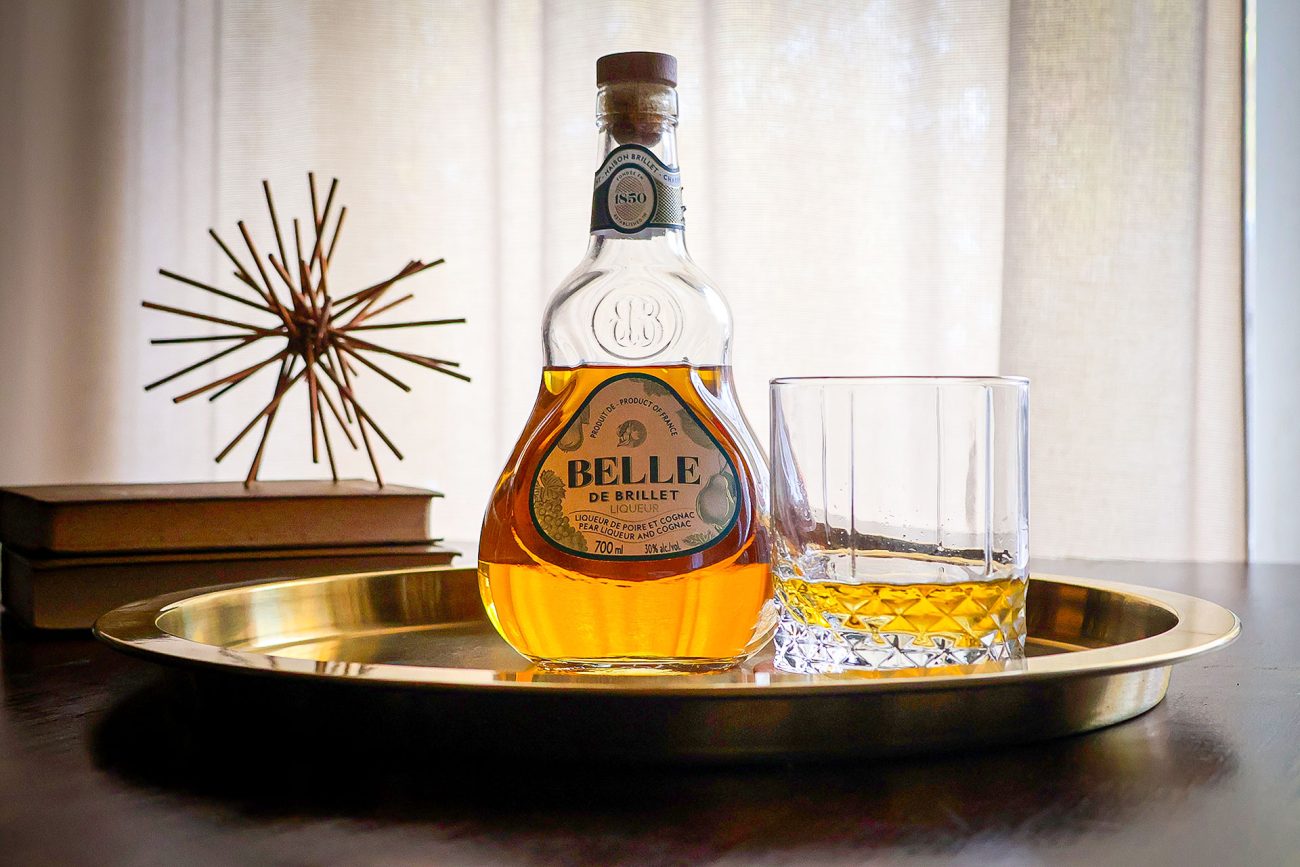
Do you know Belle de Brillet? I’ll admit that I wasn’t very familiar with the product before my meeting with Mr. Jean-Baptiste Sialelli, Executive Director of Maison Brillet at Rémy Cointreau, during his visit to Montreal in September 2024. Since its acquisition by the major cognac house in April 2020, the brand has evolved and become even more popular on shelves and in various establishments. It will undoubtedly be featured prominently in your fall cocktails or during the year-end holidays. Join me in discovering more about the brand celebrating its 40th anniversary in 2025!
A Lasting Family History

If I’m talking about Belle de Brillet today, it’s for an excellent reason: it’s been around for nearly 40 years! Jean-Baptiste Sialelli confirms: “Exactly, we’re on the cusp of Belle de Brillet’s 40th anniversary, and Jean-Louis Brillet, the tenth generation, created La Belle de Brillet in 1985.”
It’s still quite young as a product, but Mr. Sialelli notes that the family history goes back much further: “It’s both young, but the Brillet family has been established in Charente for ten generations. We had the first founding father—I can say this—with Guy Brillet in 1656. These were people who were winegrowers, and gradually, they became producers, and they wanted to develop their own brands of cognac and Pineau des Charentes. They opened their first business in 1850, and the family estate dates from around that time. It is located in the village of Graves-Saint-Amant, which is nestled on the banks of the Charente River in the heart of the Cognac region. So, Jean-Louis Brillet, in the 1980s, decided to expand his offering a bit to reach a different type of clientele, having this idea of creating Belle de Brillet by blending pear and cognac.”

He then explains the origin of this marriage between pear and cognac: “Why pear? Because, quite simply, in the orchard at the back of the garden, there were fruit trees, apples, and pears. And his grandmother often made pear tarts. So the idea came to him to partner with this type of fruit. And so it reminded him of pears. So, pear and cognac really came from his grandmother, from recipes, a bit from his youth, wanting something very fruity paired with cognac to have a more approachable, easier taste.”
The Romantic Origin of the Name
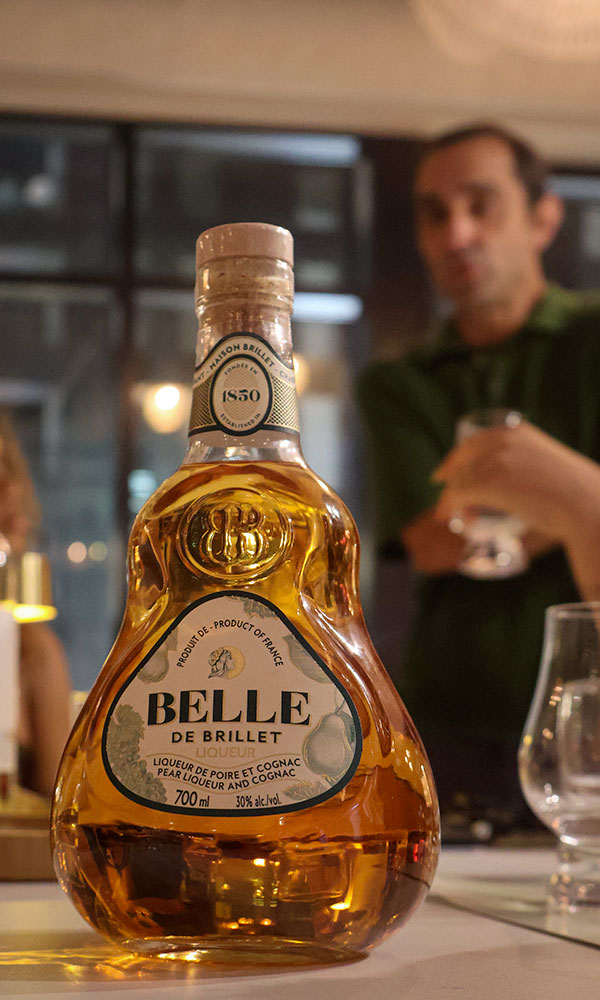
Curious to know the origin of the name, I asked him where the name “Belle de Brillet” came from. Mr. Sialelli tells a touching story: “The name Belle de Brillet simply comes from his wife’s first name, which is called Isabelle and whom he customarily calls ‘ma belle’ (my beautiful one). So it was very romantic—as a tribute to his wife, he decided to call this new product Belle, like his wife, hence the name Belle de Brillet.”
A Unique Manufacturing Process
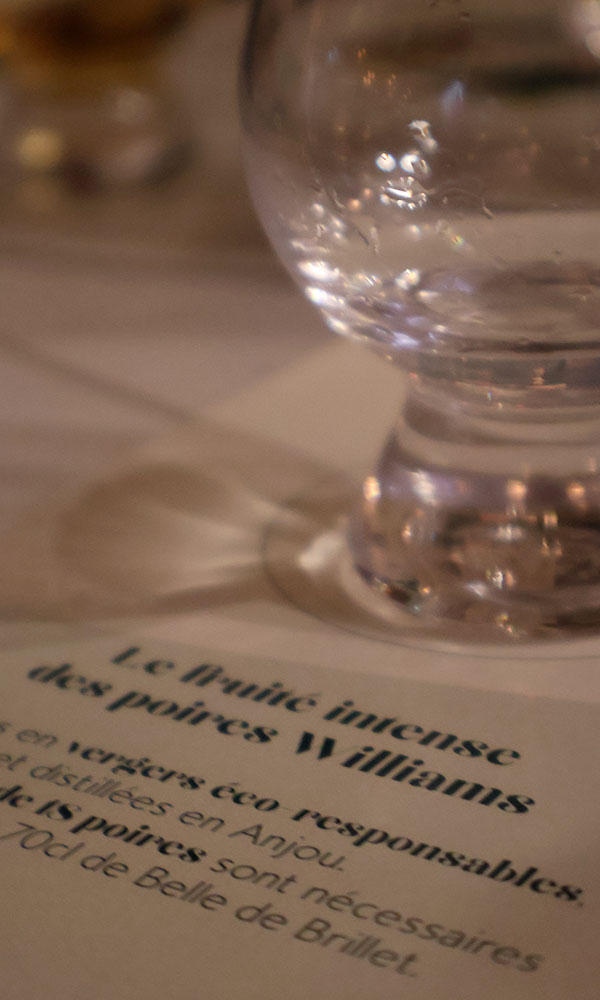
What a magnificent story! Diving into the product’s manufacturing, I wanted to know what the process was. Is it somewhat like Poire Williams? Mr. Sialelli’s answer is categorical: “Not at all! We now prepare a product that is 100% made from natural ingredients. The idea is really to use noble raw materials for a noble product in the end.”
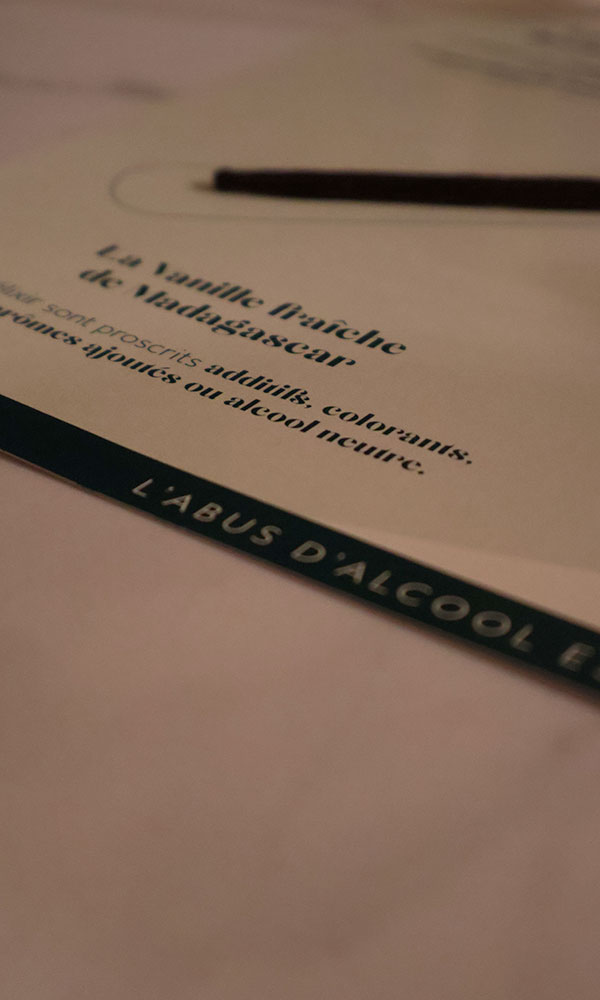
He then details the composition: “So we have three key ingredients: the pear that we work into eau-de-vie, so we have a pear eau-de-vie. We then obtain a grape eau-de-vie that becomes the cognac mentioned earlier, which we combine with fresh vanilla from Madagascar. So, these three combined ingredients allow us to create Belle de Brillet.”
When we talk about pears, we often think of Poire Williams. Do people tend to confuse the two products? Mr. Sialelli provides important nuances: “Well, the fruit we distill is indeed Williams pear, and it’s true that in many countries, including France, there was this tradition of Poire Williams as a digestif, but these are eaux-de-vie that are relatively high in alcohol content, so people are detaching themselves, they’re turning away a bit from this more traditional type of consumption that’s quite strong in alcohol. And so, with Belle de Brillet, we rediscover the pleasure of pear in this moment of consumption that can be the digestif. Because we have an alcohol content that’s quite low, which is only 30 degrees (30%), so it’s quite light. The majority of spirits are rather 40 degrees (40%), and so here, we’re on something that keeps the pear taste very fruity, very intense, but in a much more approachable way in terms of palate. And so, we rediscover this pear pleasure.”
Jean-Baptiste Sialelli’s Journey

Curious about his background, I asked him how he came to Maison Brillet. He replies: “I’ve always worked in wines and spirits—that’s my background. I found that the product and the project were wonderful. Somewhere, the idea of making the product known internationally, redeveloping it. So there you go, I had the opportunity to present all this also with Jean-Louis Brillet.”
Although the brand is now owned by Rémy Cointreau, is the family still involved? Mr. Sialelli explains the maintained connections: “Yes, not in terms of shareholding, but we share everything with them because it’s important. They have the history, yes, but I think we don’t build anything without really understanding the history well. So it was important for me from the start to exchange a lot with Jean-Louis, who still lives in the village of Graves-Saint-Amant, and it allows us to exchange with him so we can understand how he came up with the idea for the product, why it worked, to understand why it worked here in Québec, to try to evolve things while staying in the tradition. I often say that while everything has changed—the bottle shape a little bit compared to the launch, the labels have evolved a bit—ultimately we’re not so far from what was done before. For me, it’s a bit of an update.”
Food Pairings and Tasting Moments

The product is interesting, and I wanted to know how Mr. Sialelli preferred to consume it. He shares his preferences: “For me, in fact, as an aperitif, I like to drink it in cocktail form. So, a Belle Bulle makes a great cocktail. The Spritz, for example, I really like as an aperitif because it’s light and it’s easy. Ultimately, by reducing it, by adding sparkling water or prosecco, we now have a cocktail that’s 6 or 7 degrees (6–7%), it’s not very, very strong; it’s easy to drink and refreshing.”
He continues: “And then I personally like to enjoy it after a meal on ice. As an accompaniment, I find it interesting in the form of pairing—it can be with cheese, for example. Yeah, on cheeses like Comté, fairly strong soft cheeses with a rind and a tomme—it works well.”
And with blue cheese, a classic with pear? Mr. Sialelli confirms: “Yes, it works well! It pairs well with a blue cheese. On our Instagram account, we have some pastry recipes and desserts. We’ve also created recipes with friends of the Maison and with a young pastry chef, Lauryne Hervé, who works well, who loves the product, which makes simple and very, very beautiful things. For example, she made a fraisier with Belle de Brillet, or we found chocolate recipes with Belle de Brillet.”
Chocolate pear is a classic after all! Mr. Sialelli approves: “Yes, it’s a natural pairing, in fact. I think our spirit is a product that we can indeed work with in restaurants. On savoury dishes and in a dessert moment. It’s a product that’s quite comforting, so it works well at the end of a meal.”
Versatility in Mixology
Mr. Sialelli continues by discussing cocktail possibilities: “And then, you see, it’s a product that, of course, can also be used in cocktails, like long drinks based on Belle de Brillet. For example, the Belle Bulle cocktail with Belle de Brillet and Prosecco. Otherwise, we also work a lot with bartenders.”
During his visit, there was a competition, wasn’t there? Mr. Sialelli confirms enthusiastically: “Yes, exactly, we had a competition with top bartenders because, in terms of mixology, this pear ingredient is something that’s a bit missing in the bar universe in terms of taste. It’s paired with so many things, cocktails—it allows you to twist cocktails with this pear that can be married with spices. I saw one person, the winner of the competition, who worked with the idea of cheese. A very good drink!”
He adds: “So, as a substitute for anything that’s sugar syrup, using sours in Collins, we substitute with Belle de Brillet to have this pear touch. At the same time, this sweetness that will bring subtlety to the drink.”
The Comeback in Markets
Belle de Brillet’s popularity seems to be reviving. How did the product return to people’s habits after a few years of obscurity? Mr. Sialelli explains the strategy: “Well, it’s true that Québec has always been a very strong market. Historically, it’s the number one market, and we said to ourselves, if it works in Québec, why wouldn’t it work elsewhere? In fact, there’s an ambition today to develop the brand internationally, in all cocktail markets, so North American markets, meaning the United States. There’s Europe—we have Great Britain, and then there are Western European markets like France or Germany, which are traditional markets.”
Indeed, Germany with pear is classic! Mr. Sialelli agrees: “Yes, Germany with pear, Switzerland. So we’ve opened these markets. I think the concept is brilliant. If it works here, there’s no reason it won’t work elsewhere. And we’ve brought a new answer. There are fundamental elements that exist that make people perhaps drink less, but better.”
It’s really an increasingly important movement! Mr. Sialelli continues: “We have a quality product. There’s this notion of pear that’s well treated, that has a taste that’s very consensual, like vanilla. We’re not in a niche. And then my third element is that we simply believe in the quality of the product.”
The Belle de Brillet Product Range
When we hear Belle de Brillet, we often think of only one product. Are there other products in the range? Mr. Sialelli replies: “Yes, we also have cognac and Pineau des Charentes.”
But for Belle de Brillet, there isn’t an amber Belle de Brillet or something like that? He specifies: “No, there’s only one unique one. And the other products, we sell them at Maison Brillet for people who come to see us. People are doing more and more wine tourism, and we offer them more and more spirits—it allows us to bring the Brillet experience to life and to have local products in addition to our cognac and our Pineau des Charentes.”
My mother is really a Pineau des Charentes enthusiast, and I find it quite fascinating to see that Québec is also so passionate about Pineau des Charentes and Belle de Brillet at the same time. Mr. Sialelli explains this phenomenon: “I think people here really love the sweet taste, the sweet, the pear side. What made the product successful is its quite distinctive bottle shape. And then, what also made the product successful is thanks to Jean-Louis Brillet’s involvement, who for many years at the helm of the company, came to meet the various SAQ store managers—he’s a brilliant brand ambassador, in fact.”
Belle de Brillet: A Unique Position in the Spirits Universe
Belle de Brillet is really interesting as a product. I think it’s entering into a beautiful development, bringing a new flavour to cocktails that often remain in the same taste palette. Pear isn’t something we see in cocktails right now, unfortunately. Except perhaps Grey Goose pear-flavoured vodka, there aren’t many.
Mr. Sialelli shares this analysis: “Absolutely, absolutely. But it’s true that, from an opportunistic point of view, we find almost everyone in the bar world—there’s often a product associated with a taste, and it’s true that with pear, ultimately, there aren’t really any players, and it’s a great opportunity for us and for everyone, because, once again, it’s a taste that people enjoy and we can pair it with many very different things.”
What’s interesting is that cognac has a huge barrier to entry, since it’s a very strong alcohol, whereas Belle de Brillet is more accessible with its lower alcohol percentage, and even more so in cocktails. Mr. Sialelli agrees: “Yes, with an alcohol content of 30, it allows for product accessibility that might be a bit greater than going too strong in alcohol, for sure, but it also allows us to broaden our customer base. For me, it’s a product that’s both masculine and feminine.”
Sales Seasonality
As fall arrives, does the product experience seasonality in terms of sales? Mr. Sialelli confirms: “Yes, like many spirits, the last quarter of the year. But, in fact, I believe that traditionally, people in spirits restock their bars a bit for the year-end holidays. There are gift purchases and, with our beautiful bottle shape, it makes a great gift. So it’s true that, like all spirits, we have a bit of a peak at year-end.”
Tasting Belle de Brillet
I have now moved with Mr. Sialelli to taste the product in different stages. He begins by explaining the process: “The product is presented this way—we have a very traditional distillation process, then we have the Williams pear, since it’s the most aromatic. It’s picked in August; we let it over-ripen, and once there’s been over-ripening, we have a good sugar content. There’s a natural fermentation that occurs. Beforehand, of course, we’ve removed everything necessary (skin, seeds, etc.) to have a good pear compote. This will ferment on its own, which creates a sort of quite liquid pear juice, but already with alcohol. And then it’s this alcohol that we distill in a continuous still. It’s very tall still that’s 30 metres high. A plate still—it allows us to extract the quintessence of the pear aroma, and we obtain a pear eau-de-vie. A good portion of these come from the Anjou region, in western France, because it’s an arboriculture land, with many orchards.”
He then shows the cognac: “Here we have the cognac, finished in fine wood, because we want a very light cognac that will harmonize well with the pear.”
It’s a cognac that isn’t aged, in fact, I notice. Mr. Sialelli specifies: “Exactly, or very little, precisely so as not to have those overly woody notes that would break the harmony. We distill it without lees, which allows us to have this light taste.”
He continues: “Then, we use fresh vanilla, which we infuse with sugar and water to create a natural vanilla syrup.”
“And then, we blended these three products and you have Belle de Brillet. Then, to bring it down to 30 degrees, we do a reduction.”
Oh, it smells good! And it’s delicious. Mr. Sialelli describes the tasting notes: “On the nose, we’ll really find the intensity of the pear, the freshness, and the intensity of the pear. And on the palate, we’re more on the Cognac side with good balance, and we’ll finish with a slightly vanilla finish.”
It’s magnificent because it’s rich on the palate. Mr. Sialelli adds an important detail: “And so, in fact, we only work with natural products—there’s no neutral alcohol (NGS—Natural Grain Spirit), because all the alcohol comes from raw cognac, warm, magnificent.”
It’s really a pleasant product on the palate, warm, and present. I imagine this in a sour, for example, because there’s quite a bit of body. Mr. Sialelli agrees: “Of course, in a whisky sour, we can indeed replace the sugar with Belle de Brillet.”
Conclusion
What a great product idea! It was really pleasant to rediscover Belle de Brillet with Mr. Sialelli and to learn more about this unique product that combines family tradition and innovation.



